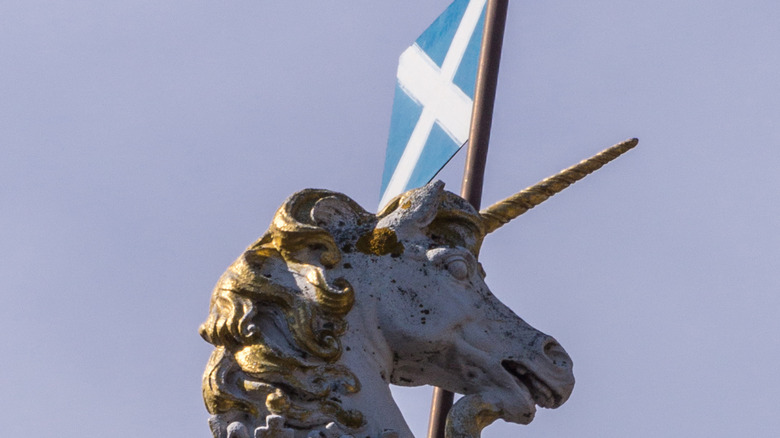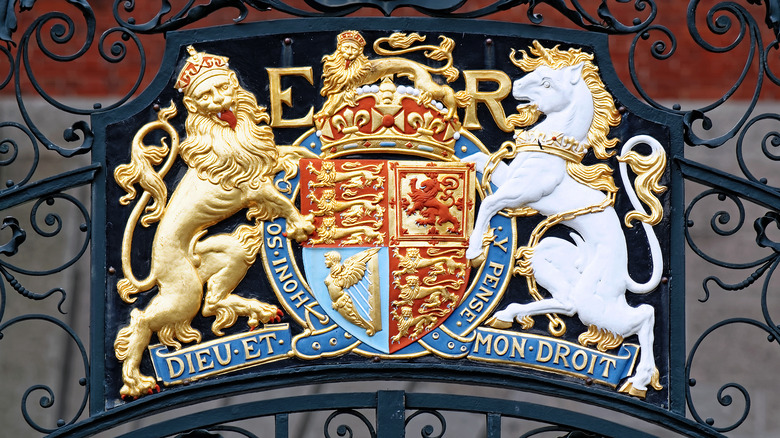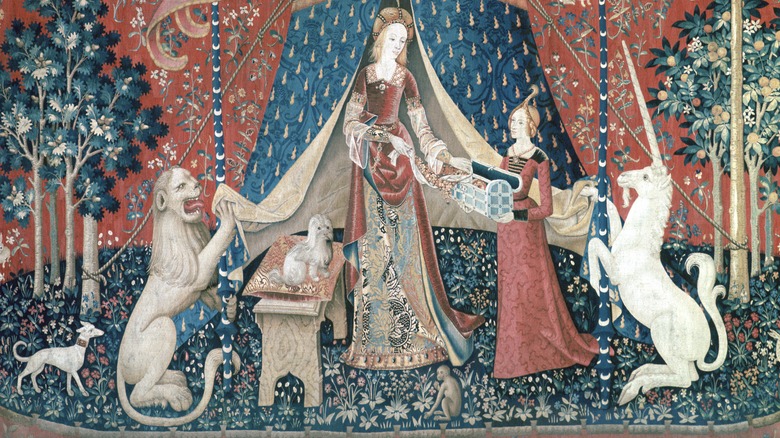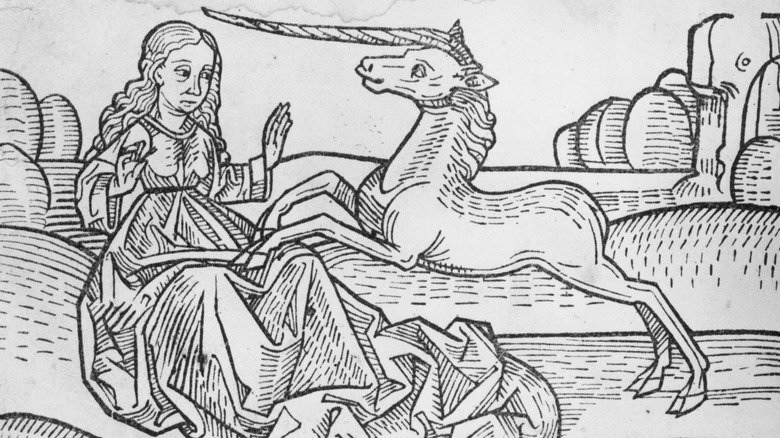Why The Unicorn Is Scotland's National Animal
"The lion and the unicorn were fighting for the crown," goes the old nursery rhyme (posted at the Rhymes website). "The lion beat the unicorn all around the town."
You may not have heard that little rhyme in childhood, or remember the characters of the Lion and the Unicorn in Lewis Carroll's "Through the Looking-Glass." But if you've ever encountered the national heraldry of the United Kingdom, and particularly of Scotland, you'll have noticed a lion and a unicorn turning up everywhere. As the U.K.'s National Trust explains, the Royal Coat of Arms of the United Kingdom features as supporters (the animals depicted "holding up" the central shield) a lion and a unicorn, and has since 1603, when James Stuart was crowned James I of England.
The lion represents England. Long a symbol of power and pride — the lion is the king of the jungle, or the king of the beasts, as any child knows — the National Trust explains that the lion made its first appearance in English royal heraldry during the reign of the fabled Richard I. Richard seems to have borrowed it from his grandfather, Geoffrey Plantagenet. The lion in British heraldry is a Barbary lion from North Africa — apparently, the Tower of London housed a few of these now-extinct beasts for years.
'Two households, both alike in dignity'
If England is represented by the lion, the unicorn represents her northern neighbor, Scotland. Visit Scotland reports that the unicorn first appeared in Scottish national heraldry in the 12th century, when William of Northumberland became William I, King of Scots. (Ironically, William was born on the English side of the Anglo-Scottish border, and was known as "William the Lion," according to Britannica.) Later, the unicorn device became so closely identified with the Scottish kings that Scottish coins featured a unicorn on one side.
When Elizabeth I died without an heir, her nearest Protestant kin was James Stuart, then James VI of Scotland. Parliament invited him to London to reign as James I of England. He accepted the new role, but brought his unicorn imagery with him, decreeing that England's royal coat of arms (seen above) should now feature the English lion on the left and the Scottish unicorn on the right, to show the equality of the two nations under his reign.
Why, exactly, did he choose the unicorn? True, other nations had adopted animal imagery — a lion for England, an eagle for Spain, and so on. As the National Museums Scotland succinctly explains, "In Scotland, James I went for the unicorn. We don't really know why."
What is it about unicorns?
Unicorns have a complex symbolism. Recent generations have gelded the unicorn, and made it an innocent as a teddy bear. But, as Visit Scotland rightly affirms, the unicorn was held to be "the strongest of all animals," who fought off hunters with the great weapon spiking out of its forehead, and susceptible only to the charms of a young woman. In the arms of a virgin, the story went, the unicorn became as docile as a lamb.
The art historian Kenneth Clark referred to the lion and the unicorn, specifically the ones shown in the Gothic tapestry above, as "emblems of lust and ferocity" in his famous BBC series "Civilisation." (The episode in question is available on YouTube). You'll notice, too, in the coat of arms shown earlier, that the way both the lion and the unicorn are depicted reinforces Lord Clark's interpretation. The unicorn also wears a chain, as Visit Scotland notes, like a savage beast that needs restraining.
The first mention of unicorns
The unicorn fascinated the world of medieval and Tudor England. As the National Trust mentions, Queen Elizabeth I owned a cup that was believed to be made of a unicorn's horn. (Was is it really narwhal tusk?)
The legend of this fascinating, violent animal is much older than that, though. Around 400 B.C., the Greek historian Ctesias wrote of a strange animal in India like a horse, but with a single horn; this may have been a rhinoceros described at second hand (via Britannica), or perhaps an antelope seen in profile. Other classical writers, like Pliny the Elder, described the unicorn as ferocious, but easily tamed by a virgin. Inspired by this, unicorns took on a Christian symbolism in the Middle Ages, replete with Virgins and spears. Maybe this duality, so characteristic of the Scots, is what made the unicorn emblematic of Scotland.
And maybe it was prophetic. Scotland's first female first minister, Nicola Sturgeon, wants independence from the U.K. History may prove her, and her Scottish National Party, as untameable as a unicorn.



